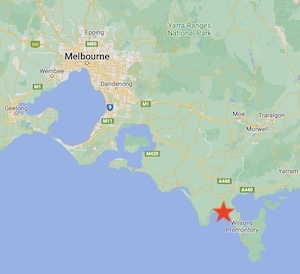Summary
 On Christmas Day in 2017, a snorkeler's chance discovery at Shallow Inlet, Sandy Point, Victoria, would set into motion an investigation that would unravel a 95-year-old mystery. Skeletal remains were found on the ocean floor, devoid of tissue, clothing, or personal effects. With no context or clues to the man's identity, Victoria Police reported the death to the coroner and transferred the remains to the Victorian Institute for Forensic Medicine (VIFM).
On Christmas Day in 2017, a snorkeler's chance discovery at Shallow Inlet, Sandy Point, Victoria, would set into motion an investigation that would unravel a 95-year-old mystery. Skeletal remains were found on the ocean floor, devoid of tissue, clothing, or personal effects. With no context or clues to the man's identity, Victoria Police reported the death to the coroner and transferred the remains to the Victorian Institute for Forensic Medicine (VIFM).
As the VIFM's team of experts began their scientific tests, they were able to infer some characteristics of the unknown person. The forensic anthropologist determined that the remains belonged to a Caucasian male, aged between 21 and 37 years, and stood at approximately 170 centimeters tall. The forensic odontologist, delving into the dental restorations, hinted at the intriguing possibility of an overseas origin or a dental work style that harked back to antiquity.
Radiocarbon testing further illuminated the timeline, indicating a 95% probability that the individual lived between 1666 and 1942. A nuclear DNA profile and a mitochondrial DNA profile were obtained from the remains. The DNA profile information was compared to the Victorian Missing Persons DNA Database and no match was found. The DNA profile was also uploaded to the National Criminal Investigation DNA Database – Integrated Forensic Analysis (NCIDD-IFA) for identification purposes, with no match.
 At one point, there was speculation that the skeletal remains could have been those of Martin Wiberg, who stole 5,000 gold sovereigns in 1877. Wiberg had escaped police custody several times and it was presumed that he drowned in 1883 in a boat off Wilsons Promontory.
At one point, there was speculation that the skeletal remains could have been those of Martin Wiberg, who stole 5,000 gold sovereigns in 1877. Wiberg had escaped police custody several times and it was presumed that he drowned in 1883 in a boat off Wilsons Promontory.
Determined to bring identity to the unknown man, the VIFM embarked on a pilot program to explore the use of forensic genetic genealogy to solve several Australian cold cases, including this case. Forensic evidence was sent to Othram's laboratory in The Woodlands, Texas and Othram scientists used Forensic-Grade Genome Sequencing® to develop a comprehensive DNA profile. Once Othram developed the DNA profile, it was returned to investigators, who then uploaded the profile to genealogical databases.
The team of investigators and researchers that performed the forensic genetic genealogy included Dr. Dadna Hartman, Fiona Leahy, and April Stock from VIFM, Dr. Jennifer Raymond and Alison Sears from the New South Wales Police Force (NSWPF), Dr. Nathan Scudder from the Australian Federal Police (AFP), and Dr. Runa Daniel from the University of New Haven. The team received mentorship from Dr. Colleen Fitzpatrick.
This investigative research resulted in a compelling lead that Sandy Point John Doe was Mr Christopher Luke Moore, a Gippsland farmer and WW1 veteran who drowned in Waratah Bay in 1928. Unearthed historical records unveiled an interesting twist—mere weeks after Christopher's drowning, a local Sandy Point farmer discovered a mandible at Shallow Inlet. Christopher's father, recognizing the distinct dental work, confirmed the mandible as his son's. The coronial inquest held on 24 January 1929 officially validated this identification.
The VIFM's findings were shared with the State Coroner, prompting the reopening of the case and its inclusion in the State Coroner's pilot program. Following the State Coroner's direction, the dedicated team at VIFM delved deeper, seeking a living connection to the past.
A possible grandniece of Christopher Luke Moore was identified, residing in Gippsland. Police contacted this vital link to history, and she graciously cooperated, confirming the family's account of Christopher's drowning and the subsequent recovery and burial of his mandible. To establish an irrefutable familial connection, the grandniece provided a DNA sample. Through confirmatory DNA analysis, the truth was confirmed—Sandy Point John Doe was indeed Christopher Luke Moore.
The State Coroner is currently undertaking a pilot using a small number of coronial cases, following the successful conclusion of two ethically approved research projects, led by the VIFM with national and interstate collaborators, which demonstrated the utility of forensic genetic genealogy in the Australian coronial context. The aim of the pilot is to develop a protocol for its use for coronial cases to enable the technique to be used more broadly for cases of unidentified human remains where every other scientific and investigative technique of identification has been exhausted. There are over 120 unsolved unidentified human remains cases, just in Victoria.
